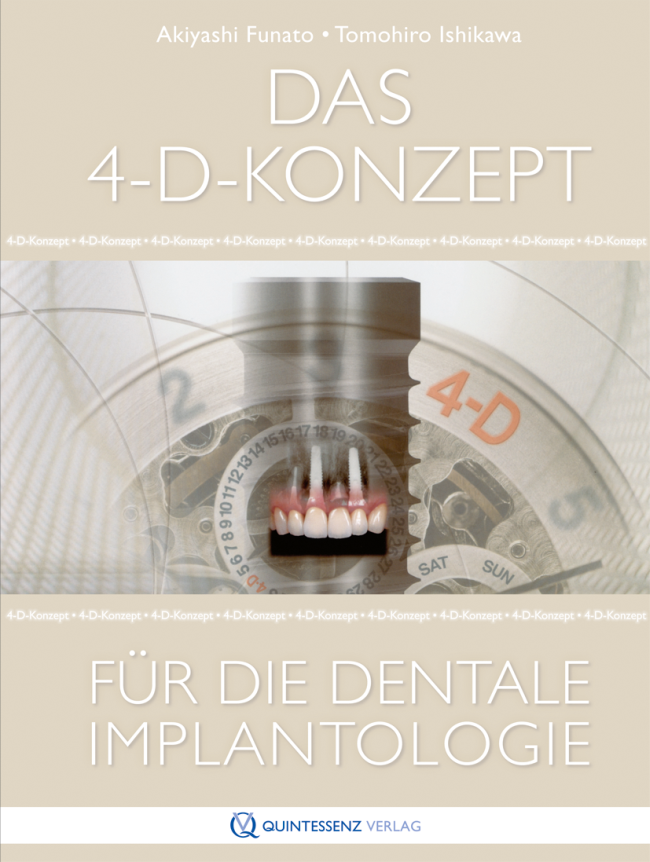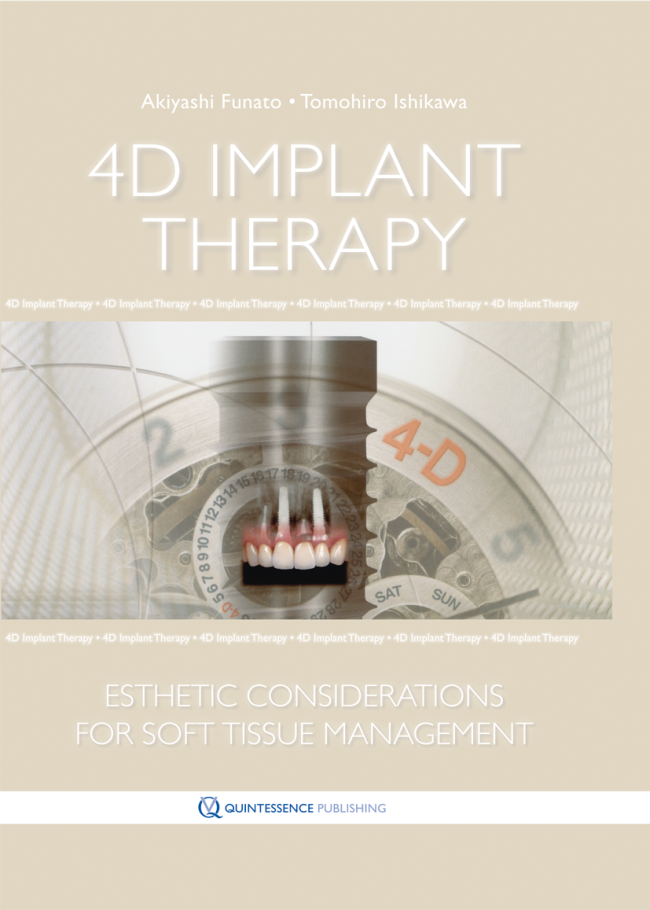International Journal of Periodontics & Restorative Dentistry, Pre-Print
DOI: 10.11607/prd.7094, PubMed-ID: 38363184Februar 16, 2024,Seiten: 1-18, Sprache: EnglischTanno, Tsutomu / Hasuike, Akira / Naito, Koji / Ishikura, Chihiro / Funato, AkiyoshiThis case series assessed the efficacy of Orthodontic Implant Site Development with Labial Root Torque (OISD-LRT) as a nonsurgical technique for addressing labial bone deficiencies in seven patients. The procedure involved strategically placing a multi-bracket of 2–3 mm apically on the hopeless teeth, gradually shifting them with Ni-Ti wires at the rate of 2 mm per month and maintaining overcorrection for 2 months before extraction. OISD-LRT consistently augmented tissue for flapless guided implant surgery, with an average treatment duration of 404Å}311.7 days. Cone-beam computed tomography (CBCT) scans at various stages revealed increases in both vertical and horizontal bone dimensions, especially in the sockets with complete labial bone loss. Despite inevitable post-extraction reductions in bone height and width, sufficient dimensions were maintained to ensure long-term implant stability. This case series highlights the effectiveness of OISD-LRT as a valuable method for horizontal bone augmentation, particularly in patients with labial bone deficiency. This approach provides a robust foundation for subsequent implant placement, showcasing its success in addressing challenging anatomical conditions and contributing to the broader field of implant dentistry.
Schlagwörter: alveolar ridge augmentation, case series, dental implantation, implants, orthodontic extrusion, torque
International Journal of Periodontics & Restorative Dentistry, Pre-Print
DOI: 10.11607/prd.6535, PubMed-ID: 37471163Juli 20, 2023,Seiten: 1-23, Sprache: EnglischFunato, Akiyoshi / Katayama, Akihiko / Moroi, HidetadaBone graft materials are often used in implant treatment for optimizing functional and esthetic outcomes. The requirements for bone grafting materials should be that they must be able to maintain space for bone regeneration to occur and must be resorbed by osteoclasts and replaced with new bone tissue occurring in passive chemolysis and bone remodeling. Carbonate apatite (CO3Ap) granules (Cytrans Granules, GC) are chemically synthetic bone graft material that are similar to autologous bone mineral and more biocompatible than allografts and xenografts. The aim of this report is to evaluate the efficacy of CO3Ap granules in implant treatments using CO3Ap granules in combination with autogenous bone or CO3Ap granules separately. This report will show the clinical findings as well as radiographic and histological assessments in three cases of immediate implant placement, lateral GBR and vertical GBR. These results demonstrated, although it was a short-term report, that in histological findings CO3Ap granules were efficiently resorbed and replaced bone in clinical use. Furthermore, the clinical findings showed that CO3Ap granules contributed to maintaining their morphology tissue around the implant. In this limited short-term case report, it was suggested that this bone substitute was effective. However, further clinical studies and long-term reports of this new biomaterial are needed.
International Journal of Periodontics & Restorative Dentistry, 4/2024
DOI: 10.11607/prd.6656, PubMed-ID: 37552182Seiten: 398-407, Sprache: EnglischSuzuki, Eiichi / Katayama, Akihiko / Funato, Akiyoshi / Rasperini, GiulioThis case series investigated the effect of a combination therapy utilizing connective tissue graft (CTG) in the treatment of periodontal regeneration of mandibular Class III/IV furcation involvement (FI). Six patients diagnosed with periodontitis stage III or IV (grade A to C), presenting with Class III or IV FI, were treated with fibroblast growth factor-2 and carbonate apatite in combination with CTG. The following clinical parameters were evaluated at baseline and after 6, 12, and 18 months: periodontal probing depth, clinical attachment level, furcation invasion, radiographic vertical defect depth, and gingival phenotype. Significant improvements in clinical parameters were observed in all treated FI sites. Four Class III defects and one Class IV defect obtained complete closure, and one Class IV defect was improved to Class I. This case series showed the potential of administering combination regenerative therapy for changing the prognosis of hopeless teeth with severe furcation defects.
International Journal of Periodontics & Restorative Dentistry, 3/2024
DOI: 10.11607/prd.6535, PubMed-ID: 38787711Seiten: 257-266, Sprache: EnglischFunato, Akiyoshi / Katayama, Akihiko / Moroi, HidetadaBone graft materials are often used in implant treatment to optimize functional and esthetic outcomes. The requirements for bone grafting materials are the ability to maintain space for bone regeneration to occur and the capability of being resorbed by osteoclasts and replaced with new bone tissue occurring in passive chemolysis and bone remodeling. Carbonate apatite (CO3Ap) granules (Cytrans Granules, GC) are a chemically synthetic bone graft material similar to autogenous bone minerals and more biocompatible than allografts and xenografts. The aim of this report is to evaluate the efficacy of CO3Ap granules in implant treatments when used alone or in combination with autogenous bone. The clinical findings and the radiographic and histologic assessments in three cases of immediate implant placement and lateral and vertical guided bone regeneration are reported. Despite the short-term follow-ups, histologic findings showed that CO3Ap granules were efficiently resorbed and replaced bone in clinical use. Furthermore, the clinical findings showed that CO3Ap granules maintained their morphology around the implant. This limited short-term case report suggests that this bone substitute is effective. However, further clinical studies and long-term reports of this new biomaterial are needed.
International Journal of Esthetic Dentistry (DE), 3/2022
Clinical ResearchSeiten: 294-310, Sprache: DeutschFunato, Akiyoshi / Moroi, Hidetada / Ogawa, TakahiroDie gegenwärtigen Knochenaugmentationstechniken und Knochenersatzmaterialien haben einige Nachteile. Um diese ausschließen zu können, wurden extrahierte Zahnwurzeln mit Parodontalligament (ZW/PDL) zur Unterstützung der gesteuerten Knochenregeneration (Guided Bone Regeneration, GBR) eingesetzt. Der Ansatz versucht, den Vorteil der autologen Natur und Formbarkeit von ZW/PDL, ihre Fähigkeit, Raum zu schaffen und zu sichern, und die Osteokonduktivität/ -induktivität des erhaltenen Parodontalligaments zu nutzen. Im vorliegenden Artikel werden drei Fälle von ZW/PDL-unterstützter GBR im Rahmen von Sofortund zweizeitigen Implantationen gezeigt. Im ersten Fall erfolgte eine Sofortimplantation in die Extraktionsalveole eines oberen zentralen Schneidezahns, wobei ein aus der Wurzel des extrahierten Zahns zugeschnittenes ZW/PDL-„Veneer“ für eine simultane laterale Augmentation zum Einsatz kam. Der zweite Fall zeigt eine verzögerte Implantation nach lateraler Augmentation eines schweren labialen Knochendefekts an der Stelle eines oberen lateralen Schneidezahns, wobei aus der Zahnwurzel eines extrahierten Weisheitszahns PDL-enthaltende Blöcke bzw. Stücke geschnitten und zusammen mit dem Knochenersatzmaterial verwendet wurden. Der dritte Fall beschreibt eine umfangreiche vertikale und horizontale Knochenaugmentation vor einer verzögerten Implantatsetzung, für die der Wurzelkomplex eines extrahierten Weisheitszahns zugeschnitten und als bukkale und linguale Klammer auf dem nativen Knochen platziert wurde. Der umklammerte Raum wurde mit Knochenersatzmaterial aufgefüllt. In allen drei Fällen wurden definitive Restaurationen eingegliedert, die bei der 3-Jahres-Nachuntersuchung stabil und funktionstüchtig waren. Die Osseointegration der Implantate blieb erhalten und die transplantierten ZW/PDL waren in den nativen oder regenerierten Knochen integriert oder remodelliert und durch nativen Knochen ersetzt. Weitere Studien mit langen Beobachtungszeiträumen zu diesem Ansatz sind notwendig.
International Journal of Esthetic Dentistry (EN), 3/2022
Clinical ResearchPubMed-ID: 36047886Seiten: 280-295, Sprache: EnglischFunato, Akiyoshi / Moroi, Hidetada / Ogawa, TakahiroTo potentially overcome current challenges in bone augmentation techniques and the limitations of bone graft materials, extracted tooth roots with periodontal ligament (TRPs) were strategically utilized to assist guided bone regeneration (GBR). This strategy sought to take advantage of the autologous and shapable nature of TRPs, along with their space-making and shielding ability, and the tissue conductivity/inductivity of the preserved periodontal ligament (PDL). The present article reports on three cases of TRP-assisted GBR as part of immediate and staged approaches to implant therapy. The first case involves immediate implant placement into the extraction socket of a maxillary central incisor, where a TRP veneer, shaped from the extracted central incisor, was used during simultaneous lateral augmentation. The second case describes a staged approach to lateral bone augmentation for a severe buccal bony defect at the maxillary lateral incisor site, where sectioned blocks/pieces of an extracted third molar TRP were used with other bone graft materials. The third case describes aggressive vertical and horizontal bone augmentation for staged implant placement, where an extracted third molar was sectioned and placed on the native alveolar bone as a buccal and lingual bracket, then filled with bone graft materials. All three cases received final restoration and were shown to be stable and functional at the 3-year follow-up. Osseointegration has been well maintained, and the transplanted TRPs seem to be integrated with the native or regenerated bone or remodeled and replaced by the native bone. Longer-term follow-up studies are required.
International Journal of Esthetic Dentistry (EN), 1/2022
Clinical ResearchPubMed-ID: 35175006Seiten: 28-40, Sprache: EnglischFunato, Akiyoshi / Moroi, HidetadaConnective tissue graft (CTG) surgery has been performed since the 1980s with the principal aim of root coverage. Various types of CTG surgery have been reported, not only for root coverage but also as a preprosthetic treatment for the prevention of gingival recession and to alleviate gingival discoloration. Although there have been numerous reports on the prognosis of such treatment, few observational case reports of 10 years or more have been published. The present article reports on five patients who were monitored from between 13 to 23 years after CTG surgery through the use of intraoral findings, CBCT, and histologic evaluation. The hypothesis of the present authors is that growth factors are released gradually from connective tissue placed either above or below the periosteum. Furthermore, stimulated by the optimal occlusion of the natural teeth, osteoblasts present on the periosteum and/or alveolar bone surrounding the teeth are stimulated. Similarly, the connective tissue itself ensures that the soft tissue has a certain biologic width. At the same time, it acts as a scaffold, resulting in the tissue being replaced by bone.
International Journal of Esthetic Dentistry (DE), 1/2022
Clinical ResearchSeiten: 26-38, Sprache: DeutschFunato, Akiyoshi / Moroi, HidetadaBindegewebstransplantate (BGT) werden seit den 1980er-Jahren primär verwendet, um exponierte Wurzeln zu decken. In der Literatur wurden seither verschiedene BGT-Techniken vorgestellt, die nicht nur für die Wurzeldeckung, sondern auch als präprothetische Maßnahme zum Verhindern von Gingivarezessionen und zum Abmildern von Gingivaverfärbungen gedacht sind. Während sich zur Prognose dieser Techniken zahlreiche Artikel finden, gibt es kaum Fallberichte mit Nachbeobachtungszeiträumen von mehr als 10 Jahren. Der vorliegende Artikel zeigt fünf Fälle, in denen die Patientinnen zwischen 13 und 23 Jahren anhand intraoraler Befunde, DVT-Aufnahmen und histologischer Auswertungen nachbeobachtet wurden. Die Autoren vertreten die Hypothese, dass von Bindegewebe, das auf oder unter dem Periost platziert wurde, langfristig Wachstumsfaktoren freigesetzt werden. Zudem stimuliert die okklusale Funktion natürlicher Zähne Osteoblasten, die sich auf dem Periost und/oder dem Alveolarknochen um die Zähne befinden. Das Bindegewebe selbst stellt eine gewisse biologische Dicke des Weichgewebes sicher und fungiert zugleich als Gerüst, während es allmählich durch Knochen ersetzt wird.
The International Journal of Oral & Maxillofacial Implants, 6/2013
DOI: 10.11607/jomi.3232, PubMed-ID: 24278928Seiten: 1589-1601, Sprache: EnglischFunato, Akiyoshi / Ogawa, TakahiroPurpose: Ultraviolet (UV) light treatment of titanium, or photofunctionalization, has been shown to enhance its osteoconductivity in animal and in vitro studies, but its clinical performance has yet to be reported. This clinical case series sought to examine the effect of photofunctionalization on implant success, healing time, osseointegration speed, and peri-implant marginal bone level changes at 1 year after restoration.
Materials and Methods: Four partially edentulous patients were included in the study. Seven implants with identical microroughened surfaces were photofunctionalized with UV light for 15 minutes. Osseointegration speed was calculated by measuring the increase in implant stability quotient (ISQ) per month. Marginal bone levels were evaluated radiographically at crown placement and at 1 year.
Results: All implants placed into fresh extraction sockets, vertically augmented bone, simultaneously augmented sinuses, or the site of a failing implant remained functional and healthy at 1 year, even with an earlier loading protocol (2.1 to 4.5 months). ISQs of 48 to 75 at implant placement had increased to 68 to 81 at loading. In particular, implants with low primary stability (initial ISQ 70) showed large increases in ISQ. The speed of osseointegration of photofunctionalized implants was considerably greater than that of as-received implants documented in the literature. Mean marginal bone levels were -0.35 ± 0.71 mm at crown placement and had significantly increased to 0.16 ± 0.53 mm at 1 year, with coronal gains in marginal bone level that surpassed the implant platform. No implants showed marginal bone loss.
Conclusions: Within the limits of this study, photofunctionalization expedited and enhanced osseointegration of commercial dental implants in various clinically challenging/compromised bone conditions. Photofunctionalization resulted in preservation-and often a gain-of marginal bone level, and long-term large-scale clinical validation is warranted.
The International Journal of Oral & Maxillofacial Implants, 5/2013
DOI: 10.11607/jomi.3263, PubMed-ID: 24066316Seiten: 1261-1271, Sprache: EnglischFunato, Akiyoshi / Yamada, Masahiro / Ogawa, TakahiroPurpose: This is the first study to report the clinical outcomes of photofunctionalized dental implants.
Materials and Methods: This retrospective study analyzed 95 consecutive patients who received 222 untreated implants and 70 patients who received 168 photofunctionalized implants over a follow-up period of 2.5 years. Photofunctionalization was performed by treating implants with UV light for 15 minutes using a photo device immediately before placement. The generation of superhydrophilicity and hemophilicity along with a substantial reduction in atomic percentage of surface carbon was confirmed after photofunctionalization. In both groups, 90% of the implants were placed in complex cases requiring staged or simultaneous site-development surgery. The implant stability was measured at implant placement and loading using the implant stability quotient (ISQ) values; then, the rate of implant stability development was evaluated by calculating the ISQ increase per month.
Results: The healing time before functional loading was 3.2 months in photofunctionalized implants and 6.5 months in untreated implants. The success rate was 97.6% and 96.3% for photofunctionalized and untreated implants, respectively. The ISQ increase per month for photofunctionalized implants ranged from 2.0 to 8.7 depending on the ISQ at placement, and it was considerably higher than that of untreated implants reported in the literature ranging from -1.8 to 2.8. Photofunctionalization resulted in a more frequent use of implants of 10 mm or shorter length and an overall decrease in implant diameter.
Conclusions: Within the limits of this retrospective study, despite the more frequent use of shorter and smaller-diameter implants, the use of photofunctionalization allowed for a faster loading protocol without compromising the success rate. The outcome was associated with an increased rate of implant stability development. The results suggest that photofunctionalization may provide a novel and practical avenue to further advance implant therapy.






